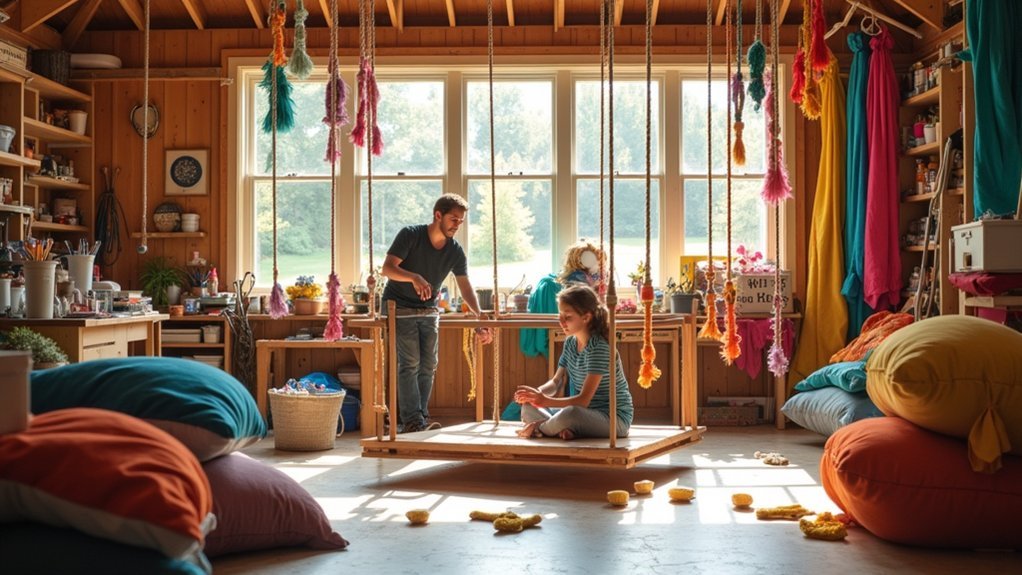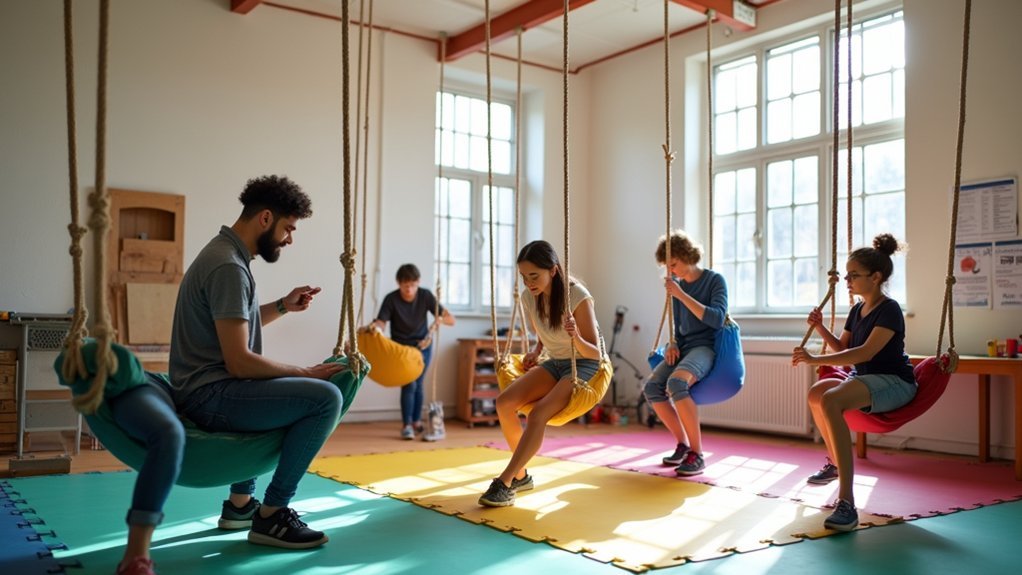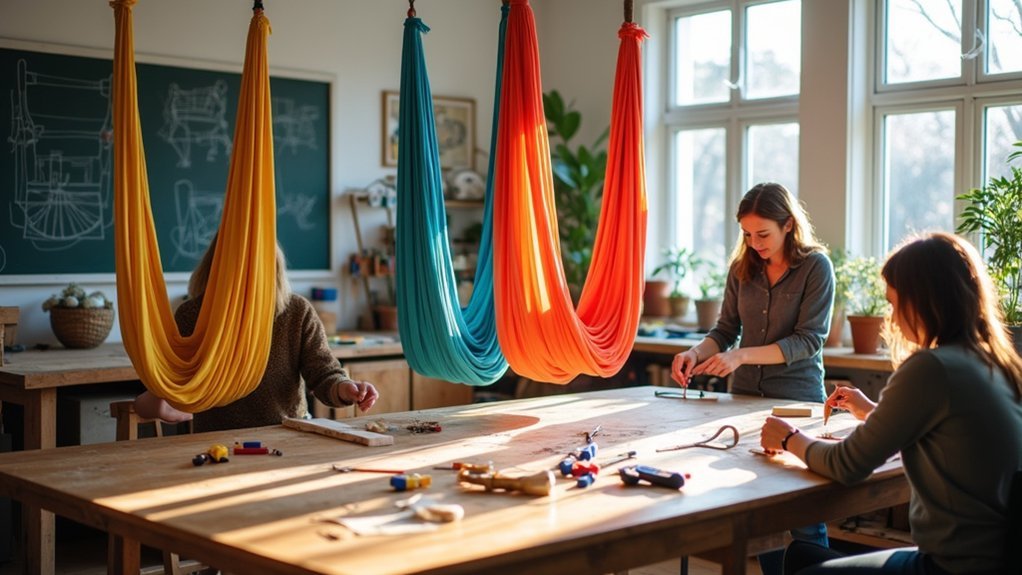Sensory swings provide essential vestibular input that helps children with autism regulate emotions, improve focus, and reduce anxiety. You’ll need durable fabrics like canvas or lycra, sturdy mounting hardware, and proper installation techniques to guarantee safety. Consider your child’s specific sensory needs when choosing between cocoon, platform, or stretchy swing styles. Always maintain proper clearance and secure mounting to structural supports. The right sensory swing can transform your home into a therapeutic space where sensory regulation becomes part of daily routine.
Building Sensory Swings for Autism Support

While many therapeutic tools require specialized equipment, sensory swings offer a practical and effective support option for children with autism. These swings provide essential vestibular input that helps regulate sensory needs and reduce anxiety in children who struggle with sensory processing.
You can create DIY sensory swings using affordable materials like fabric, ropes, and sturdy frames. Cocoon swings create a comforting, enclosed environment, while platform swings help develop balance and postural control.
When building your swing, prioritize safety by ensuring all hardware is securely mounted and placing cushioning mats underneath.
Incorporating these swings into daily routines not only provides sensory regulation but also improves coordination and offers a fun physical outlet for children with autism to release energy.
Understanding the Sensory Benefits of Swings
Because the vestibular system plays a crucial role in sensory processing, sensory swings offer powerful therapeutic benefits for children with autism. When your child engages with a swing, they receive consistent vestibular input that helps regulate their sensory system, creating a calming effect that can reduce anxiety during overwhelming moments.
You’ll notice how swings designed for deep pressure, particularly cocoon-style options, simulate the comfort of a secure hug, providing a safe space for your child to self-regulate. This gentle motion doesn’t just soothe—it actively builds body awareness and proprioceptive skills essential for developing coordination and balance.
The benefits extend beyond swing time too. Regular sessions can improve your child’s attention span and concentration, helping them shift more successfully to structured activities afterward.
Types of Therapeutic Swings for Different Sensory Needs

Since each child with autism experiences sensory input differently, selecting the right therapeutic swing can markedly impact their development and comfort.
Stretchy swings offer deep pressure that mimics a comforting hug, ideal for children with autism seeking sensory regulation.
Cocooning swings provide a calming space where overwhelmed children can retreat and reset their sensory processing needs.
For active vestibular input that enhances balance, moon swings allow for versatile positioning while standing or kneeling.
Platform swings deliver stability for developing postural control through interactive play, particularly beneficial for those needing structured sensory experiences.
When relaxation is the goal, hammock swings create cozy retreats suitable for both children with autism and caregivers, accommodating various body sizes and sensory preferences.
Essential Materials and Tools for DIY Sensory Swings
Creating effective DIY sensory swings requires gathering specific materials and tools that prioritize both safety and sensory benefits.
You’ll need durable fabric like heavy-duty canvas or cotton that can withstand regular movement and support weight consistently. Pair this with sturdy ropes or straps rated for the intended load to guarantee safe suspension.
A strong frame or proper hanging kit is non-negotiable for stability during use. Remember to place safety mats underneath the swing area to protect against falls.
Always select non-toxic materials, especially important for children with sensory sensitivities who might touch or chew on surfaces.
For assembly, you’ll need basic tools: a sewing machine or kit, scissors, and hardware like eye bolts and carabiners to secure everything properly.
These essentials create a foundation for a safe, therapeutic swing experience.
Safety Considerations for Indoor Swing Installation

You’ll need to secure your sensory swing to proper structural supports like ceiling joists or dedicated swing frames, never attaching to drywall or decorative fixtures alone.
Create a safety zone by maintaining at least 2 feet of clearance from the floor, walls, and furniture to prevent injuries during swinging activities.
This protective buffer allows your child to enjoy the full range of motion while minimizing collision risks with surrounding objects.
Proper Structural Support
Safety remains the cornerstone of any sensory swing installation for children with autism. Before mounting any sensory tools, you’ll need to thoroughly assess the structural integrity of your ceiling or walls.
Look for exposed support beams or studs that can bear the combined weight of the swing and its user during dynamic movement.
Always attach your swing to heavy-duty installation points using appropriate hardware like eye bolts or swing hangers rated for the intended weight limit. This prevents dangerous failures during use.
Verify you maintain a safe space around the swing with at least 2 feet of clearance from the floor and ample room to avoid collisions with nearby furniture or walls.
Don’t forget to regularly inspect all mounting components for signs of wear, replacing damaged parts immediately to maintain a secure environment.
Clearance Zone Requirements
Proper mounting is only half the safety equation when installing sensory swings for autism support. Creating adequate clearance zones guarantees swings provide calming benefits while protecting children with sensory sensitivities.
| Clearance Area | Minimum Requirement | Why It Matters |
|---|---|---|
| Floor to swing | 2 feet clearance | Prevents floor impacts during use |
| Surrounding space | 3-5 feet on all sides | Avoids collisions with objects |
| Hanging points | Within clearance zone | Guarantees stability and safety |
| Doorway width | Swing narrower than frame | Allows for door operation |
| Regular inspection | Check for obstructions | Maintains safe operation |
You’ll need to measure your space carefully before installation. When properly positioned, sensory swings create a secure environment where children can experience therapeutic movement without safety concerns. Remember that different swing types may require adjusting these clearance specifications.
Step-by-Step Guide to Doorway Swing Mounting
When installing a sensory swing in a doorway, following a systematic approach guarantees both safety and functionality.
Begin by selecting a proper Doorway Bar that fits securely within your frame while supporting the necessary weight. Check the structural integrity of your doorway before proceeding to verify it can handle the stress.
- Measure and install – Position your Doorway Bar, making sure it’s level and secure enough for double-point suspension if your swing requires it.
- Attach mounting hardware – Connect the suspension points firmly, testing by applying weight before final installation.
- Hang and test – Install your Cocoon Climbing Swing, maintaining at least 2 feet of clearance from the floor for safe usage.
Remember to regularly check all components for wear to maintain peak safety.
Ceiling Installation Techniques for Secure Sensory Swings
While doorway installations offer convenience, ceiling mounts provide greater stability and swing radius for sensory experiences.
Before installing sensory swings, locate sturdy ceiling joists that can support both the swing and user’s weight.
Always assess the structural integrity of your ceiling by checking for damage on potential mounting areas.
Select single-point suspension systems and guarantee all mounting hardware is properly rated for the intended weight capacity.
Though you might feel confident in your DIY skills, hiring a professional installer is often the safest choice.
They’ll secure your swing using appropriate techniques and hardware specific to your ceiling type.
Don’t forget to maintain at least 2 feet of clearance from the swing’s bottom to the floor, with ample space around to prevent wall collisions during use.
Creating Customizable Pod and Cocoon Swings
When building pod and cocoon swings, you’ll need to select fabrics that balance sensory comfort with durability, such as stretchy lycra for gentle pressure or textured materials for tactile input.
You can enhance your swing’s therapeutic value by incorporating customizable elements like removable cushions, weighted blankets, or different fabric layers that adapt to your child’s changing sensory needs.
Consider adding optional sensory features such as pockets for fidget toys, scented fabric inserts, or LED string lights to create a truly personalized sensory retreat that grows with your child.
DIY Fabric Selection
Selecting the right fabric stands as the foundation of any successful DIY sensory swing project.
You’ll want to prioritize durable materials like canvas or heavy-duty cotton that can withstand regular use while providing necessary support. Choose breathable fabrics that offer comfort and prevent overheating, as children with autism often have sensory sensitivities to temperature and texture.
Consider fabrics with these key characteristics:
- Slight stretch – Materials with spandex blends deliver deep pressure sensations that many children find calming.
- Vibrant colors – Stimulating visual interest while remaining mindful of individual preferences.
- Pre-washed quality – Prevents shrinkage and removes potential irritants for sensitive skin.
Fabrics with the right balance of durability, comfort, and sensory appeal will create a swing that truly meets your child’s unique needs.
Sensory Adaptation Options
Everyone deserves a sensory space tailored to their unique needs, which is why customizable pod and cocoon swings have become essential tools for autism support. You can enhance these sensory swings for kids by adding features that provide varied vestibular stimulation and deep pressure input.
| Adaptation | Benefits |
|---|---|
| Stretchy fabrics | Creates snug environment for calming effect |
| Adjustable suspension | Customizes height and motion intensity |
| Weighted blankets | Enhances body awareness and security |
| Textured materials | Enriches tactile sensory experience |
| Various sizes/shapes | Supports your child’s specific comfort needs |
Platform Swing Designs for Enhanced Proprioception
Platform swings stand out as essential tools in sensory integration therapy because they provide consistent, stable feedback to the vestibular and proprioceptive systems simultaneously.
When you incorporate these swings into your therapy space, you’ll notice improved body awareness and core strength in children with autism as they engage with the stable surface that enhances proprioceptive feedback.
For maximum benefit in motor skills development, consider these design features:
- Non-slip surfaces that guarantee safety while children challenge their balance and postural control
- Secure harnesses that allow freedom of movement while maintaining safety
- Larger platforms that accommodate multiple users, promoting social interaction during therapy sessions
These designs support therapeutic goals while creating opportunities for family playtime and group activities, making proprioceptive development both effective and enjoyable.
Portable and Freestanding Swing Frame Options
While platform swings offer exceptional proprioceptive benefits, many families need flexibility in where and how they implement sensory support. Portable swing frames provide an excellent solution, allowing you to quickly assemble and disassemble equipment as needed across different environments.
These freestanding swing frames accommodate both single and double-point suspension systems, maximizing your options for delivering varied sensory input. Look for models with adjustability features that let you customize height settings based on your child’s needs and preferred swinging motions.
Safety remains paramount—quality frames use durable materials designed to support specific weight limits without compromising stability.
This convenient alternative eliminates permanent installation requirements while still delivering valuable movement opportunities. Whether in therapy rooms, backyards, or living spaces, these versatile structures create consistent sensory experiences wherever your family needs them.
Maintenance and Durability Tips for Long-Term Use
To guarantee your sensory swing remains a reliable therapeutic tool for years to come, establishing a consistent maintenance routine is vital.
Regular inspections of all components—from fabric to hardware and hanging mechanisms—will guarantee both safety and peak functionality during therapeutic use.
Follow these important maintenance practices:
- Wash removable covers regularly – Many sensory swings feature washable covers that maintain hygiene and extend the swing’s lifespan.
- Respect weight limits – Adhere to manufacturer guidelines to prevent structural failures that compromise safety.
- Protect from elements – Store your swing in a dry, sheltered area when not in use to prevent material deterioration.
Choosing durable materials specifically designed for therapeutic applications guarantees your sensory swing withstands regular use while continuing to provide valuable sensory input.
Frequently Asked Questions
How Does Sensory Swing Help Autism?
Sensory swings help you by providing calming vestibular input that soothes anxiety and promotes relaxation. You’ll experience improved focus, better body awareness, and emotional regulation while enjoying a secure environment that meets your sensory processing needs.
How Do You Create a Sensory Room for Autism?
To create a sensory room for autism, you’ll need soft lighting, tactile objects, physical activity equipment like swings, cozy retreat spaces, and calming colors. Don’t forget to establish structured routines to minimize anxiety.
What Is the Best Material for a Sensory Swing?
For sensory swings, you’ll want durable nylon or canvas for strength, combined with soft cotton for comfort. Don’t forget to include elastic components like spandex that provide that calming, cocoon-like feeling many users love.
What Type of Swing Is Used for Sensory Integration?
Platform swings, pod swings, cocooning swings, bolster swings, trapeze swings, and sling swings are all used for sensory integration. You’ll find each type provides different benefits for processing vestibular and proprioceptive input.
In Summary
Building a sensory swing offers invaluable support for your loved one with autism. You’ll create a safe space that meets their unique sensory needs while developing essential motor skills. Whether you’ve chosen a pod, platform, or cocoon design, your DIY project provides therapeutic benefits right at home. Remember to check installations regularly and adapt as needed. Your dedication to customizing this sensory tool can make a profound difference in daily comfort.





Leave a Reply